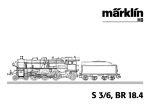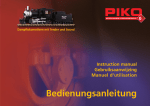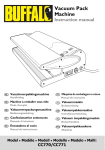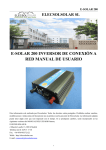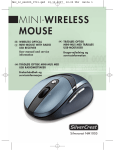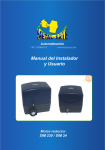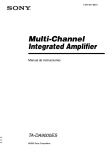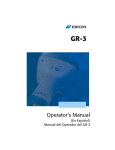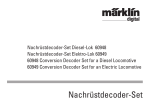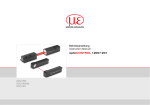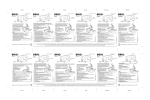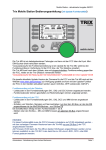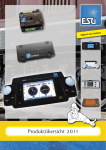Download Modell der BR 50
Transcript
Modell der BR 50 21522 Inhaltsverzeichnis:Seite Hinweise zur Inbetriebnahme 3 Sicherheitshinweise4 Wichtige Hinweise 4 Multiprotokollbetrieb4 Schaltbare Funktionen 5 CVs und Parameter 6 Ergänzendes Zubehör 26 Wartung und Instandhaltung 27 Ersatzteile31 Indice de contenido:Página Notas para la puesta en servicio 3 Aviso de seguridad 16 Notas importantes 16 Funcionamiento multiprotocolo 16 Funciones posibles 17 CVs y parámetros 18 Accesorios complementarios 26 El mantenimiento 27 Recambios 31 Table of Contents:Page Notes about using this model for the first time 3 Safety Notes 7 Important Notes 7 Multi-Protocol Operation 7 Controllable Functions 8 CVs and Parameters 9 Complementary accessories 26 Service and maintenance 27 Spare Parts 31 Indice del contenuto:Pagina Avvertenza per la messa in esercizio 3 Avvertenze per la sicurezza 19 Avvertenze importanti 19 Esercizio multi-protocollo 19 Funzioni commutabili 20 CV e parametri 21 Accessori complementari 26 Manutenzione ed assistere 27 Pezzi di ricambio 31 Sommaire :Page Indications relatives à la mise en service 3 Remarques importantes sur la sécurité 10 Information importante 10 Mode multiprotocole 10 Fonctions commutables 11 CVs et paramètres 12 Accessoires complémentaires 26 Entretien et maintien 27 Pièces de rechange 31 Innehållsförteckning:Sidan Bruksanvisningar för körning 3 Säkerhetsanvisningar22 Viktig information 22 Multiprotokollkörning 22 Kopplingsbara funktioner 23 CV och parametrar 23 Ytterligare tillbehör 26 Underhåll och reparation 27 Reservdelar 31 Inhoudsopgave:Pagina Opmerking voor de ingebruikname 3 Veiligheidsvoorschriften13 Belangrijke aanwijzing 13 Multiprotocolbedrijf13 Schakelbare functies 14 CV’s en parameter 15 Aanvullende toebehoren 26 Onderhoud en handhaving 27 Onderdelen31 Indholdsfortegnelse:Side Henvisninger til ibrugtagning 3 Vink om sikkerhed 24 Vigtige bemærkninger 24 Multiprotokoldrift24 Styrbare funktioner 25 CV‘er og parametre 25 Ekstra tilbehør 26 Service og reparation 27 Reservedele 31 2 Radius > 500 mm Radius > 500 mm Kurzkupplung zwischen Lok und Tender verstellbar Close coupling between locomotive and tender is adjustable Attelage court réglable entre locomotive et tender Kortkoppeling tussen loc en tender is verstelbaar El enganche corto ajustable entre locomotora y ténder Aggancio corto regolabile tra locomotiva e tender Kortkopplet mellan lok och tender kan regleras Kortkobling mellem lok og tender indstillelig 3 Sicherheitshinweise • Die Lok darf nur mit einem dafür bestimmten Betriebssystem eingesetzt werden. • Analog max. 15 Volt =, digital max. 22 Volt ~. • Die Lok darf nur aus als einer Leistungsquelle versorgt werden. • Beachten Sie unbedingt die Sicherheitshinweise in der Bedienungsanleitung zu Ihrem Betriebssystem. • Für den konventionellen Betrieb der Lok muss das Anschlussgleis entstört werden. Dazu ist das Entstörset 611 655 zu verwenden. Für Digitalbetrieb ist das Entstörset nicht geeignet. • ACHTUNG! Funktionsbedingte scharfe Kanten und Spitzen. • Setzen Sie das Modell keiner direkten Sonneneinstrahlung, starken Temperaturschwankungen oder hoher Luftfeuchtigkeit aus. Wichtige Hinweise • Die Bedienungsanleitung und die Verpackung sind Bestandteile des Produktes und müssen deshalb aufbewahrt sowie bei Weitergabe des Produktes mitgegeben werden. • Wartung, Instandhaltung und Reparaturen dürfen nur durch Erwachsene durchgeführt werden. • Für Reparaturen oder Ersatzteile wenden Sie sich bitte an Ihren Trix-Fachhändler. • Gewährleistung und Garantie gemäß der beiliegenden Garantieurkunde. • Entsorgung: www.maerklin.com/en/imprint.html • Der volle Funktionsumfang ist nur unter Trix Systems, DCC und unter mfx verfügbar. • Eingebaute, fahrtrichtungsabhängige Stirnbeleuchtung. Im Digitalbetrieb schaltbar. • Befahrbarer Mindestradius 360 mm. • Rauchsatz nachrüstbar. einige Einstellungen von Funktionen, welche im AnalogBetrieb wirksam sein sollen, vorgenommen werden. Hinweise zum Digitalbetrieb • Die genaue Vorgehensweise zum Einstellen der diversen Parameter entnehmen Sie bitte der Bedienungsanleitung Ihrer Mehrzug-Zentrale. • Die ab Werk eingestellten Werte sind so gewählt, dass ein bestmöglichstes Fahrverhalten gewährleistet ist. • Der Betrieb mit gegenpoliger Gleichspannung im Bremsabschnitt ist mit der werkseitigen Einstellung nicht möglich. Ist diese Eigenschaft gewünscht, so muss auf den konventionellen Gleichstrombetrieb verzichtet werden (CV 29/Bit 2 = 0). mfx-Protokoll Adressierung • Keine Adresse erforderlich, jeder Decoder erhält eine einmalige und eindeutige Kennung (UID). • Der Decoder meldet sich an einer Central Station oder Mobile Station mit seiner UID automatisch an. Programmierung • Die Eigenschaften können über die grafische Oberfläche der Central Station bzw. teilweise auch mit der Mobile Station programmiert werden. • Es können alle Configurations Variablen (CV) mehrfach gelesen und programmiert werden. • Die Programmierung kann entweder auf dem Haupt- oder dem Programmiergleis erfolgen. • Die Defaulteinstellungen (Werkseinstellungen) können wieder hergestellt werden. • Funktionsmapping: Funktionen können mit Hilfe der Central Station 60212 (eingeschränkt) und mit der Central Station 60213/60214/60215 beliebigen Funktionstasten zugeordnet werden (siehe Hilfe in der Central Station). Multiprotokollbetrieb DCC-Protokoll Analogbetrieb Der Decoder kann auch auf analogen Anlagen oder Gleisabschnitten betrieben werden. Der Decoder erkennt die analoge Gleichspannung (DC) automatisch und passt sich der analogen Gleisspannung an. Es sind alle Funktionen, die unter mfx oder DCC für den Analogbetrieb eingestellt wurden aktiv (siehe Digitalbetrieb). Adressierung • Kurze Adresse – Lange Adresse – Traktionsadresse • Adressbereich: 1 - 127 kurze Adresse, Traktionsadresse 1 - 10239 lange Adresse • Jede Adresse ist manuell programmierbar. • Kurze oder lange Adresse wird über die CVs ausgewählt. • Eine angewandte Traktionsadresse deaktiviert die Standard-Adresse. Digitalbetrieb Der Decoder ist ein Multiprotokolldecoder. Der Decoder kann unter folgenden Digital-Protokollen eingesetzt werden: mfx oder DCC. Das Digital-Protokoll mit den meisten Möglichkeiten ist das höchstwertige Digital-Protokoll. Die Reihenfolge der DigitalProtokolle ist in der Wertung fallend: Priorität 1: mfx Priorität 2: DCC Priorität 3: DC Hinweis: Digital-Protokolle können sich gegenseitig beeinflussen. Für einen störungsfreien Betrieb empfehlen wir, nicht benötigte Digital-Protokolle mit CV 50 zu deaktivieren. Deaktivieren Sie, sofern dies Ihre Zentrale unterstützt, auch dort die nicht benötigten Digital-Protokolle. Werden zwei oder mehrere Digital-Protokolle am Gleis erkannt, übernimmt der Decoder automatisch das höchst wertige Digital-Protokoll, z.B. mfx/DCC, somit wird das mfxDigital-Protokoll vom Decoder übernommen. Hinweis: Beachten Sie, dass nicht alle Funktionen in allen Digital-Protokollen möglich sind. Unter mfx und DCC können 4 Programmierung • Die Eigenschaften können über die Configurations Variablen (CV) mehrfach geändert werden. • Die CV-Nummer und die CV-Werte werden direkt eingegeben. • Die CVs können mehrfach gelesen und programmiert werden (Programmierung auf dem Programmiergleis). • Die CVs können beliebig programmiert werden (Programmierung auf dem Hauptgleis PoM). PoM ist nur bei den in der CV-Tabelle gekennzeichneten CV möglich. Die Programmierung auf dem Hauptgleis (PoM) muss von Ihrer Zentrale unterstützt werden (siehe Bedienungsanleitung ihres Gerätes). • Die Defaulteinstellungen (Werkseinstellungen) können wieder hergestellt werden. • 14 bzw. 28/126 Fahrstufen einstellbar. • Automatisches Bremsen (CV 27 = Wert 16) • Alle Funktionen können entsprechend dem Funktionsmapping geschaltet werden. • Weitere Information, siehe CV-Tabelle DCC-Protokoll. Es wird empfohlen, die Programmierungen grundsätzlich auf dem Programmiergleis vorzunehmen. Logische Funktionen Anfahr-/Bremsverzögerung • Die Beschleunigungs- und Bremszeit kann getrennt voneinander eingestellt werden. • Die logische Funktionsabschaltung ABV kann über das Funktionsmapping auf jede beliebige Funktionstaste gelegt werden. 1 Schaltbare Funktionen 5 STOP f0 - f3 f4 - f7 f0 f8 f8 f0 mobile station Stirnbeleuchtung an Funktion f0 Funktion f0 Rauchgenerator 1 — Funktion 1 Funktion f1 Funktion f1 Geräusch: Betriebsgeräusch — Funktion 2 Funktion f2 Funktion f2 Geräusch: Lokpfeife — Funktion 3 Funktion f3 Funktion f3 Geräusch: Bremsenquietschen aus — Funktion 5 Funktion f4 Funktion f4 Geräusch: Kohle schaufeln — Funktion 6 Funktion f6 Funktion f6 Geräusch: Glocke — Funktion 7 Funktion f7 Funktion f7 ABV aus — Funktion 8 Funktion f8 Funktion f8 Geräusch: Luftpumpe — — Funktion f9 Funktion f9 Geräusch: Schüttelrost — — Funktion f10 Funktion f10 Geräusch: Dampf ablassen — — Funktion f11 Funktion f11 Geräusch: Schaffnerpfiff — — Funktion f12 Funktion f12 Geräusch: Bahnhofsansage — — Funktion f13 Funktion f13 Geräusch: Bahnhofsansage Abfahrt — — Funktion f14 Funktion f14 Geräusch: Fahrkartenkontrolle — — Funktion f15 Funktion f15 1 Gehört nicht zum Lieferumfang. 5 CV 1 Wert DCC Adresse ab Werk 1 - 127 3 2 PoM Minimalgeschwindigkeit 0 - 255 10 3 PoM Anfahrverzögerung 0 - 255 12 4 PoM Bremsverzögerung 0 - 255 15 5 PoM Maximalgeschwindigkeit 0 - 255 240 131 8 Werkreset/Herstellerkennung 8 13 PoM Funktionen F1 - F8 im Analogbetrieb 0 - 255 0 14 PoM Funktionen F9 - F15 und Licht im Analogbetrieb 0 - 255 1 17 Erweiterte Adresse (oberer Teil) CV 29, Bit 5 =1 192 18 Erweiterte Adresse (unterer Teil) CV 29, Bit 5 =1 128 19 Traktionsadresse 21 PoM Funktionen F1 - F8 bei Traktion 22 PoM Funktionen F9 - F15 und Licht bei Traktion 29 Bit 0: Umpolung Fahrtrichtung Bit 1: Anzahl Fahrstufen 14 oder 28/128* PoM Bit 2: DCC Betrieb mit Bremsstrecke (kein Analogbetrieb möglich) Bit 5: Adressumfang 7 Bit / 14 Bit 63 PoM Lautstärke PoM * *** 6 Bedeutung 0/1 0/2 0/4 0 / 32 0 - 255 0 0 - 255 0 0 - 255 0 *** 0, 1, 2, 3, 4, 5, 6, 7, 32, 34, 35, 36, 37, 38, 39 6 0 - 255 255 Program on the Main; muss vom Steuergerät unterstützt werden Fahrstufen am Lokdecoder und am Steuergerät müssen übereinstimmen, es sind sonst Fehlfunktionen möglich. Die Werte der gewünschten Einstellungen sind zu addieren! Safety Notes • This locomotive is only to be used with the operating system it is designed for. • Analog max. 15 volts DC, digital max. 22 volts AC. • This locomotive must never be supplied with power from more than one power pack. • Please make note of the safety notes in the instructions for your operating system. • The feeder track must be equipped to prevent interference with radio and television reception, when the locomotive is to be run in conventional operation. The 611 655 interference suppression set is to be used for this purpose. The interference suppression set is not suitable for digital operation. • WARNING! Sharp edges and points required for operation. • Do not expose the model to direct sunlight, extreme changes in temperature, or high humidity. Important Notes • The operating instructions and the packaging are a component part of the product and must therefore be kept as well as transferred along with the product to others. • Maintenance, servicing, and repairs may only be done by adults. • Please see your authorized Trix dealer for repairs or spare parts. • The warranty card included with this product specifies the warranty conditions. • Disposing: www.maerklin.com/en/imprint.html • The full range of functions is only available under Trix Systems and under DCC. • Built-in headlights that change over with the direction of travel. They can be turned on and off in digital operation. • Minimum radius for operation is 360 mm/14-3/16“. • A smoke generator can be retrofitted to the locomotive also for analog operation. Multi-Protocol Operation Analog Operation This decoder can also be operated on analog layouts or areas of track that are analog. The decoder recognizes alternating current (DC) and automatically adapts to the analog track voltage. All functions that were set under mfx or DCC for analog operation are active (see Digital Operation). Digital Operation The decoders are multi-protocol decoders. These decoders can be used under the following digital protocols: mfx or DCC. The digital protocol with the most possibilities is the highest order digital protocol. The sequence of digital protocols in descending order is: Priority 1: mfx Priority 2: DCC Priority 3: DC Note: Digital protocols can influence each other. For troublefree operation, we recommend deactivating those digital protocols not needed by using CV 50. Deactivate unneeded digital protocols at this CV if your controller supports this function. If two or more digital protocols are recognized in the track, the decoder automatically takes on the highest order digital protocol, example: mfx/DCC; the decoder takes on the mfx digital protocol (see previous table). Note: Please note that not all functions are possible in all digital protocols. Several settings for functions, which are supposed to be active in analog operation, can be done under mfx and DCC. Notes on digital operation • The operating instructions for your central unit will give you exact procedures for setting the different parameters. • The values set at the factory were selected to guarantee the best possible running characteristics. • The setting done at the factory does not permit operation with opposite polarity DC power in the braking block. If you want this characteristic, you must do without conventional DC power operation (CV 29/Bit 2 = 0). mfx Protocol Addresses • No address is required; each decoder is given a onetime, unique identifier (UID). • The decoder automatically registers itself on a Central Station or a Mobile Station with its UID. Programming • The characteristics can be programmed using the graphic screen on the Central Station or also partially with the Mobile Station. • All of the Configuration Variables (CV) can be read and programmed repeatedly. • The programming can be done either on the main track or the programming track. • The default settings (factory settings) can be produced repeatedly. • Function mapping: Functions can be assigned to any of the function buttons with the help of the 60212 Central Station (with limitations) and with the 60213/60214/60215 Central Station (See help section in the Central Station). DCC Protocol Addresses • Short address – long address – multiple unit address • Address range: 1 - 127 for short address and multiple unit address, 1 - 10239 for long address • Every address can be programmed manually. • A short or a long address is selected using the CVs. • A multiple unit address that is being used deactivates the standard address. Programming • The characteristics can be changed repeatedly using the Configuration Variables (CV). • The CV numbers and the CV values are entered directly. • The CVs can be read and programmed repeatedly. (Programming is done on the programming track.) • The CVs can be programmed in any order desired. (Programming can be done on the main track PoM). The PoM can only be done with those designated in the CV table. Programming on the main track PoM must be supported by your central controller (Please see the description for this unit.). • The default settings (factory settings) can be produced repeatedly. • 14/28 or 126 speed levels can be set. • All of the functions can be controlled according to the function mapping (see CV description). • See the CV description for the DCC protocol for additional 7 information. We recommend that in general programming should be done on the programming track. Logic Functions Acceleration/Braking Delay • The acceleration and braking time can be set separately from each other. • The logic function ABV can be assigned to any function button by using the function mapping. 1 Controllable Functions 5 STOP f0 - f3 f4 - f7 f0 f8 f8 f0 mobile station Headlights on Function f0 Function f0 Smoke generator 1 — Function 1 Function f1 Function f1 Sound effect: Operating sounds — Function 2 Function f2 Function f2 Sound effect: Locomotive whistle — Function 3 Function f3 Function f3 Sound effect: Squealing brakes off — Function 5 Function f4 Function f4 Sound effect: Coal being shoveled — Function 6 Function f6 Function f6 Sound effect: Bell — Function 7 Function f7 Function f7 ABV off — Function 8 Function f8 Function f8 Sound effect: Air pump — — Function f9 Function f9 Sound effect: Rocker grate — — Function f10 Function f10 Sound effect: Blowing off steam — — Function f11 Function f11 Sound effect: Conductor whistle — — Function f12 Function f12 Sound effect: Station announcements — — Function f13 Function f13 Sound effect: Departure announcement — — Function f14 Function f14 Sound effect: Ticket Control — — Function f15 Function f15 1 Not included in delivery scope. 8 CV Discription DCC Value Factory-Set 1 Address 1 - 127 3 2 PoM Minimum Speed 0 - 255 10 3 PoM Acceleration delay 0 - 255 12 4 PoM Braking delay 0 - 255 15 5 PoM Maximum speed 0 - 255 240 8 131 13 8 PoM Functions F1 - F8 in analog operation Factory Reset / Manufacturer Recognition 0 - 255 0 14 PoM Functions F9 - F15 and lights in analog operation 0 - 255 1 17 Extended address (upper part) CV 29, Bit 5 =1 192 18 Extended address (lower part) CV 29, Bit 5 =1 128 19 Multiple Unit Address 21 PoM Functions F1 - F8 on Multiple Unit 22 PoM Functions F9 - F15 and lights on Multiple Unit 29 Bit 0: Reversing direction Bit 1: Number of speed levels 14 or 28/128* PoM Bit 2: DCC operation with braking area (no analog operation possible) Bit 5: Address length 7 Bit / 14 Bit 63 PoM Volume 0/1 0/2 0/4 0 / 32 0 - 255 0 0 - 255 0 0 - 255 0 *** 0, 1, 2, 3, 4, 5, 6, 7, 32, 34, 35, 36, 37, 38, 39 6 0 - 255 255 PoM Program on the Main; must be supported by the controller * The speed levels on the locomotive decoder and on the controller must agree with each other; otherwise, you may have malfunc- tions. *** The values for the desired settings must be added. 9 Remarques importantes sur la sécurité • La locomotive ne peut être utilisée qu‘avec le système d‘exploitation indiqué. • Analogique max. 15 Volt =, digital max. 22 Volt ~. • La locomotive ne peut pas être alimentée électriquement par plus d‘une source de courant à la fois. • Il est impératif de tenir compte des remarques sur la sécurité décrites dans le mode d‘emploi de votre système d‘exploitation. • Pour l’exploitation de la locomotive en mode conventionnel, la voie de raccordement doit être déparasitée. A cet effet, utiliser le set de déparasitage réf. 611 655. Le set de déparasitage ne convient pas pour l’exploitation en mode numérique. • ATTENTION! Pointes et bords coupants lors du fonctionnement du produit. • Ne pas exposer le modèle à un ensoleillement direct, à de fortes variations de température ou à un taux d‘humidité important. Information importante • La notice d‘utilisation et l’emballage font partie intégrante du produit ; ils doivent donc être conservés et, le cas échéant, transmis avec le produit. • Seules des personnes adultes sont habilitées pour l’entretien, la maintenance et les réparations. • Pour toute réparation ou remplacement de pièces, adressez vous à votre détaillant-spécialiste Trix. • Garantie légale et garantie contractuelle conformément au certificat de garantie ci-joint. • Elimination : www.maerklin.com/en/imprint.html • L’intégralité des fonctions est disponible uniquement en exploitation Trix Systems, DCC et mfx. • Feux de signalisation s‘inversant selon le sens de marche; feux commutables en exploitation digital. • Rayon minimal d’inscription en courbe 360 mm. • Installation ultérieure d’un générateur de fumée possible - également pour exploitation analogique. Mode multiprotocole Mode analogique On peut aussi faire fonctionner le décodeur sur des installations ou des sections de voie analogiques. Le décodeur identifie automatiquement la tension de voie analogique (CC). Toutes les fonctions qui ont été paramétrée pour le mode analogique sous mfx ou sous DCC sont actives (voir mode numérique). Mode numérique Les décodeur sont des décodeur multiprotocole. Le décodeur peut être utilisé avec les protocoles numériques suivants : mfx, DCC Le protocole numérique offrant les possibilités les plus nombreuses est le protocole numérique à bit de poids fort. La hiérarchisation des protocoles numériques est descendante : Priorité 1 : mfx Priorité 2 : DCC Priorité 3 : DC Indication : des protocoles numériques peuvent s’influencer réciproquement. Pour une exploitation sans perturbations, nous recommandons de désactiver avec CV 50 des protocoles numériques non nécessaires. Dans la mesure où votre centrale les supporte, désactivez y aussi les protocoles numériques non nécessaires. Lorsque deux ou plusieurs protocoles numériques sont identifiés au niveau de la voie, le décodeur reprend automatiquement le protocole numérique à bit de poids fort, p. ex. 10 mfx/DCC. Le protocole numérique mfx est donc repris par le décodeur (voir tableau antérieur). Indication : remarquez que toutes les fonctions ne peuvent pas être actionnées dans tous les protocoles numériques. Sous mfx et sous DCC, il est possible de procéder à quelques paramétrages de fonctions devant être actives dans le cadre de l’exploitation analogique. Remarques relatives au fonctionnement en mode digital • En ce qui concerne la procédure de réglage des divers paramètres, veuillez vous référer au mode d‘emploi de votre centrale de commande multitrain. • Les valeurs paramétrées d’usine sont choisies de manière à garantir le meilleur comportement de roulement possible. • L’exploitation avec courant continu de polarité inverse dans les sections de freinage n’est pas possible avec le réglage d’usine. Si cette propriété est désirée, il faut alors renoncer à l’exploitation conventionnelle en courant continu (CV 29/Bit 2 = 0). Protocole mfx Adressage • Aucune adresse n’est nécessaire, le décodeur reçoit toutefois une identification unique et non équivoque (UID). • Avec son UID, le décodeur indique automatiquement à une station centrale ou à une station mobile qu’il est connecté. Programmation • Les caractéristiques peuvent être programmées par l’intermédiaire de la couche graphique de la station centrale, voire en partie aussi au moyen de la station mobile. • Toutes les configurations variables (CV) peuvent être lues et programmées de façon réitérée. • La programmation peut être réalisée soit sur la voie principale, soit sur la voie de programmation. • Les paramétrages par défaut (paramétrages usine) peuvent être rétablis. • Mappage des fonctions : les fonctions peuvent être affectées à de quelconques touches de fonction au moyen de la station centrale (60212) (restreinte) et avec la station centrale 60213/60214/60215 (voir Aide au niveau de la station centrale). Protocole DCC Adressage • Adresse brève – adresse longue – adresse de traction. • Champ d’adresse : 1 – 127 adresse brève, adresse de traction 1 – 10239 adresse longue • Chaque adresse est programmable manuellement. • L’adresse brève ou longue est choisie par l’intermédiaire des CVs. • Une adresse de traction utilisée désactive l’adresse standard. Programmation • Les caractéristiques peuvent être modifiées de façon réitérée par l’intermédiaire des variables de configuration (CVs). • Toutes les configurations variables (CV) peuvent être lues et programmées de façon réitérée. • La programmation peut être réalisée soit sur la voie principale, soit sur la voie de programmation. • Les CVs peuvent être programmées librement (programmation de la voie principale (PoM). La PoM n’est possible que pour les CVs identifiées dans le tableau des CVs. La programmation sur la voie principale (PoM) doit être supportée par votre centrale (voir mode d’emploi de votre appareil). • Les paramétrages par défaut (paramétrages usine) peuvent être rétablis. • 14/28, voire 126 crans de marche sont paramétrables. • Toutes les fonctions peuvent être commutées en fonction du mappage des fonctions (voir le descriptif des CVs). • Pour toute information complémentaire, voir le tableau des CVs, protocole DCC. Il est recommandé, de réaliser la programmation, fondamentalement, sur la voie de programmation. Fonctions logiques Retard au démarrage / au freinage • Les temps d’accélération et de freinage peuvent être paramétrés séparément les uns des autres. • Par l’intermédiaire du mappage des fonctions, la mise hors fonction de la fonction logique ABV peut être affectée à n’importe quelle touche de fonction. 1 Fonctions commutables 5 STOP Fanal f0 - f3 f4 - f7 f0 f8 f8 f0 mobile station Fonction f0 Fonction f0 Générateur de fumée 1 activé — Fonction 1 Fonction f1 Fonction f1 Bruitage : Bruit d’exploitation — Fonction 2 Fonction f2 Fonction f2 Bruitage : Sifflet locomotive — Fonction 3 Fonction f3 Fonction f3 Bruitage : Grincement de freins désactivé — Fonction 5 Fonction f4 Fonction f4 Bruitage : Pelletage du charbon — Fonction 6 Fonction f6 Fonction f6 Bruitage : Cloche — Fonction 7 Fonction f7 Fonction f7 ABV, désactivé — Fonction 8 Fonction f8 Fonction f8 Bruitage : Compresseur — — Fonction f9 Fonction f9 Bruitage : Grille à secousses — — Fonction f10 Fonction f10 Bruitage : Échappement de la vapeur — — Fonction f11 Fonction f11 Bruitage : Sifflet Contrôleur — — Fonction f12 Fonction f12 Bruitage : Annonce en gare — — Fonction f13 Fonction f13 Bruitage : Annonce du départ — — Fonction f14 Fonction f14 Bruitage : Contrôle des billets — — Fonction f15 Fonction f15 1 Ne fait pas partie de la fourniture. 11 CV 1 Affectaion DCC Valeur 1 - 127 3 2 PoM Vitesse minimale 0 - 255 10 3 PoM Temporisation d‘accélération 0 - 255 12 4 PoM Temporisation de freinage 0 - 255 15 5 PoM Vitesse maximale 0 - 255 240 8 131 8 Adresse Parm. Usine Réinitialisation d’usine/identification du fabricant 13 PoM Fonctions F1 - F8 en mode analogique 0 - 255 0 14 PoM Fonctions F9 - F15 et éclairage en mode analogique 0 - 255 1 17 Adresse étendue (partie supérieure) CV 29, Bit 5 =1 192 18 Adresse étendue (partie inférieure) CV 29, Bit 5 =1 128 19 Adresse traction 21 PoM Fonctions F1 - F8 pour traction 22 PoM Fonctions F9 - F15 et éclairage traction 29 Bit 0: Inv. polarité Sens de marche Bit 1: Nombre de crans de marche 14 ou 28/128* PoM Bit 2: Mode DCC avec dist. de freinage (pas possible en mode analogique) Bit 5: Capacité d’adresses 7 Bit / 14 Bit 63 PoM Volume PoM * *** 12 0/1 0/2 0/4 0 / 32 0 - 255 0 0 - 255 0 0 - 255 0 *** 0, 1, 2, 3, 4, 5, 6, 7, 32, 34, 35, 36, 37, 38, 39 6 0 - 255 255 Program on the Main; doit être pris en charge par l’appareil de commande Pour éviter tout dysfonctionnement, les crans de marche sur le décodeur de loco doivent impérativement coïncider avec ceux de l’appareil de commande. Les valeurs des réglages désirés sont à additioner. Veiligheidsvoorschriften • De loc mag alleen met een daarvoor bestemd bedrijfssysteem gebruikt worden. • Analoog max. 15 Volt =, digitaal max. 22 Volt ~. • De loc mag niet vanuit meer dan een stroomvoorziening gelijktijdig gevoed worden. • Lees ook aandachtig de veiligheidsvoorschriften in de gebruiksaanwijzing van uw bedrijfssysteem. • Voor het conventionele bedrijf met de loc dient de aansluitrail te worden ontstoort. Hiervoor dient men de ontstoor-set 611 655 te gebruiken. Voor het digitale bedrijf is deze ontstoor-set niet geschikt. • OPGEPAST! Functionele scherpe kanten en punten. • Stel het model niet bloot aan in directe zonnestraling, sterke temperatuurwisselingen of hoge luchtvochtigheid. Belangrijke aanwijzing • De gebruiksaanwijzing en de verpakking zijn een bestanddeel van het product en dienen derhalve bewaard en meegeleverd te worden bij het doorgeven van het product. • Onderhoud, herstellingen en reparaties mogen alleen door volwassenen uitgevoerd worden. • Voor reparaties en onderdelen kunt zich tot Uw Trix handelaar wenden. • Vrijwaring en garantie overeenkomstig het bijgevoegde garantiebewijs. • Afdanken: www.maerklin.com/en/imprint.html • De volledige toegang tot alle functies is alleen mogelijk met Trix Systems, DCC of met mfx bedrijf. • Ingebouwde, rijrichtingsafhankelijke frontverlichting is in het digitaalsysteem schakelbaar. • Minimale te berijden radius: 360 mm. • Rookgenerator nadien in te bouwen. ingesteld worden. Aanwijzingen voor digitale besturing • Het op de juiste wijze instellen van de diverse parameters staat beschreven in de handleiding van uw digitale Centrale. • De vanaf de fabriek ingestelde waarden zijn zo ingesteld dat de rij-eigenschappen optimaal zijn. • Het bedrijf met tegengepoolde gelijkspanning in de afremsectie is met de fabrieksinstelling niet mogelijk. Indien deze eigenschap wenselijk is, dan moet worden afgezien van het conventioneel gelijkstroombedrijf (CV 29/Bit 2 = 0). Mfx-protocol Adressering • Een adres is niet nodig, elke decoder heeft een éénmalig en éénduidig kenmerk (UID). • De decoder meldt zich vanzelf aan bij het Central Station of Mobile Station met zijn UID. Programmering • De eigenschappen kunnen m.b.v. het grafische scherm op het Central Station resp. deels ook met het Mobile Station geprogrammeerd worden. • Alle configuratie variabelen (CV) kunnen vaker gelezen en geprogrammeerd worden. • De programmering kan zowel op het hoofdspoor als op het programmeerspoor gebeuren. • De default-instellingen (fabrieksinstelling) kunnen weer hersteld worden. • Functiemapping: functies kunnen met behulp van het Central Station 60212 (met beperking) en met het Central Station 60213/60214/60215 aan elke gewenste functietoets worden toegewezen (zie het helpbestand in het Central Station. Multiprotocolbedrijf DCC-protocol Analoogbedrijf De decoder kan ook op analoge modelbanen of spoortrajecten gebruikt worden. De decoder herkent de analoge gelijkspanning (DC) automatisch en past zich aan de analoge railspanning aan. Alle functies die onder mfx of DCC voor het analoge bedrijf zijn ingesteld, worden geactiveerd (zie digitaalbedrijf). Adressering • Kort adres – lang adres – tractie adres • Adresbereik: 1 – 127 kort adres, tractie adres 1 – 10239 lang adres • Elk adres is handmatig programmeerbaar. • Kort of lang adres wordt via de CV gekozen. • Een toegepast tractieadres deactiveert het standaardadres. Digitaalbedrijf De Decoder is een multiprotocoldecoder. De decoder kan onder de volgende digitale protocollen ingezet worden: mfx, DCC. Het digitaalprotocol met de meeste mogelijkheden is het primaire digitaalprotocol. De volgorde van de digitaalprotocollen is afnemend in mogelijkheden: Prioriteit 1: mfx Prioriteit 2: DCC Prioriteit 3: DC Opmerking: de digitale protocollen kunnen elkaar beïnvloeden. Voor een storingsvrij bedrijf is het aan te bevelen de niet gebruikte protocollen met CV 50 te deactiveren. Deactiveer eveneens, voor zover uw centrale dit ondersteunt, ook de daar niet gebruikte digitale protocollen. Worden twee of meer digitaal protocollen op de rails herkend, dan neemt de decoder automatisch het protocol met de hoogste prioriteit, bijv. mfx/DCC, dan wordt door de decoder het mfx-digitaalprotocol gebruikt (zie bovenstaand overzicht). Opmerking: let er op dat niet alle functies in alle digitaalprotocollen mogelijk zijn. Onder mfx of DCC kunnen enkele instellingen, welke in analoogbedrijf werkzaam moeten zijn, Programmering • De eigenschappen van de decoder kunnen via de configuratie variabelen (CV) vaker gewijzigd worden. • De CV-nummers en de CV-waarden worden direct ingevoerd. • De CV’s kunnen vaker gelezen en geprogrammeerd worden (programmering op het programmeerspoor). • De CV’s kunnen naar wens geprogrammeerd worden (programmering op het hoofdspoor PoM). PoM is alleen bij de in de CV-tabel aangegeven CV’s mogelijk. De programmering op het hoofdspoor (PoM) moet door uw centrale ondersteund worden (zie de gebruiksaanwijzing van uw apparaat). • De default-instellingen (fabrieksinstelling) kunnen weer hersteld worden. • 14/28 resp. 126 rijstappen instelbaar. • Alle functies kunnen overeenkomstig de functiemapping geschakeld worden (zie CV-beschrijving). • Voor verdere informatie, zie de CV-tabel DCC-protocol. Het is aan te bevelen om het programmeren alleen op het programmeerspoor uit te voeren. 13 Fysieke functies Logische functies Aangezien deze functies uitsluitend via de software uitgevoerd worden, is hier geen fysieke uitgang voor nodig. Daarom spreekt men hier dan ook van een logische functie. 1 Schakelbare functies 5 STOP f0 - f3 f4 - f7 f0 f8 f8 f0 mobile station Frontverlichting aan Functie f0 Functie f0 Rookgenerator 1 — Functie 1 Functie f1 Functie f1 Geluid: bedrijfsgeluiden — Functie 2 Functie f2 Functie f2 Geluid: locfluit — Functie 3 Functie f3 Functie f3 Geluid: piepende remmen uit — Functie 5 Functie f4 Functie f4 Geluid: kolenscheppen — Functie 6 Functie f6 Functie f6 Geluid: luidklok — Functie 7 Functie f7 Functie f7 ABV, uit — Functie 8 Functie f8 Functie f8 Geluid: luchtpomp — — Functie f9 Functie f9 Geluid: schudrooster — — Functie f10 Functie f10 Geluid: stoom afblazen — — Functie f11 Functie f11 Geluid: conducteurfluit — — Functie f12 Functie f12 Geluid: stationsomroep — — Functie f13 Functie f13 Geluid: vertrektekst — — Functie f14 Functie f14 Geluid: kaartcontrole — — Functie f15 Functie f15 1 Maakt geen deel uit van het leveringspakket. 14 CV 1 2 Betekenis Waarde DCC Adres PoM Minimale snelheid Af fabriek 1 - 127 3 0 - 255 10 3 PoM Optrekvertraging 0 - 255 12 4 PoM Afremvertraging 0 - 255 15 5 PoM Maximumsnelheid 0 - 255 240 8 131 8 Fabrieksinstelling/fabriekherkenning 13 PoM functies F1 - F8 in analoogbedrijf 0 - 255 0 14 PoM functies F9 - F15 en licht in analoogbedrijf 0 - 255 1 17 Uitgebreld adres (bovenste gedeelte) CV 29, Bit 5 =1 192 18 Uitgebreld adres (onderste gedeelte) CV 29, Bit 5 =1 128 19 tractieadres 21 PoM functies F1 - F8 in tractie 22 PoM functies F9 - F15 en licht in tractie 29 Bit 0: ompolen rijrichting Bit 1: aantal rijstappen 14 of 28/128* PoM Bit 2: DCC bedrijf met afremtraject (geen analoogbedrijf mogelijk) Bit 5: adresomvang 7 Bit / 14 Bit 63 PoM Volume PoM * *** 0/1 0/2 0/4 0 / 32 0 - 255 0 0 - 255 0 0 - 255 0 *** 0, 1, 2, 3, 4, 5, 6, 7, 32, 34, 35, 36, 37, 38, 39 6 0 - 255 255 Program on the Main; dient door het besturingsapparaat ondersteunt te worden. De rijstappen instelling op de decoder en het besturingsapparaat moeten met elkaar overeenkomen anders kunnen er storingen optreden. De waarde van de gewenste instellingen moeten bij elkaar opgeteld worden. 15 Aviso de seguridad • La locomotora solamente debe funcionar en el sistema que le corresponda. • Analógicas máx. 15 voltios =, digitales máx. 22 voltios ~. • La locomotora no deberá recibir corriente más que de un solo punto de abasto a la vez. • Observe necesariamente los avisos de seguridad indicados en las instrucciones correspondientes a su sistema de funcionamiento. • Para el funcionamiento convencional de la locomotora deben suprimirse las interferencias en la vía de conexión de la alimentación. Para ello debe emplearse el set supresor de interferencias 611 655. • ¡ATENCIÓN! Esquinas y puntas afiladas condicionadas a la función. • No exponer el modelo en miniatura a la radiación solar directa, a oscilaciones fuertes de temperatura o a una humedad del aire elevada. Notas importantes • Las instrucciones de empleo y el embalaje forman parte íntegra del producto y, por este motivo, deben guardarse y entregarse junto con el producto en el caso de venderlo o transmitirlo a otro. • El mantenimiento, la conservación y las reparaciones deben ser realizadas siempre por adultos. • En caso de precisar una reparación o piezas de recambio, rogamos ponerse en contacto con su distribuidor Trix. • Responsabilidad y garantía conforme al documento de garantía que se adjunta. • Eliminación: www.maerklin.com/en/imprint.html • La plena funcionalidad de funciones está disponible sólo en Trix Systems, DCC y en mfx. • Los faros frontales dependen del sentido de la marcha. En Digital se pueden encender y apagar. • Radio mínimo describe 360 mm. • Kit de humo equipable posteriormente. Funcionamiento multiprotocolo Modo analógico El decoder puede utilizarse también en maquetas de trenes o tramos de vía analógicos. El decoder detecta la tcontinua analógica (DC) automáticamente, adaptándose a la tensión de vía analógica. Están activas todas las funciones que hayan sido configuradas para el modo analógico en mfx o DCC (véase Modo digital). Modo digital Los decoders son decoders multiprotocolo. El decoder puede utilizarse con los siguientes protocolos digitales: mfx, DCC. El protocolo digital que ofrece el mayor número de posibilidades es el protocolo digital de mayor peso. El orden de pesos de los protocolos digitales es descendente.: Prioridad 1: mfx Prioridad 2: DCC Prioridad 3: DC Nota: Los protocolos digitales pueden afectarse mutuamente. Para asegurar un funcionamiento sin anomalías recomendamos desactivar con la CV 50 los protocolos digitales no necesarios. Desactive, en la medida en que su central lo soporte, también en ésta los protocolos digitales no necesarios. Si se detectan dos o más protocolos digitales en la vía, el decoder aplica automáticamente el protocolo digital de mayor peso, p. ej. mfx/DCC, siendo por tanto asumido por el 16 decoder el protocolo digital mfx (véase tabla anterior). Nota: Tenga presente que no son posibles todas las funciones en todos los protocolos digitales. En mfx y DCC pueden configurarse algunos parámetros de funciones que deben tener efecto en el modo analógico Informaciones para el funcionamiento digital • Deberá consultar el procedimiento exacto de configuración de los diversos parámetros en el manual de instrucciones de la central multitren que desee utilizar. • Los valores configurados en fábrica se han elegido de modo que queden garantizadas las mejores características de conducción posibles. • No es posible el funcionamiento con tensión de corriente continua de polaridad opuesta en el tramo de frenado en funcionamiento en modo DCC. Si se desea esta característica, debe renunciarse al funcionamiento convencional con corriente continua (CV 29/Bit 2 = 0). Protocolo mfx Direccionamiento • No se requiere direccionamiento, recibiendo cada decoder una identificación universalmente única e inequívoca (UID) • El decoder se da de alta automáticamente en una Central Station o en una Mobile Station con su UID: Programación • Las características pueden programarse mediante la interfaz gráfica de la Central Station o bien en parte también con la Mobile Station. • Es posible leer y programar múltiples veces todas las Variables de Configuración (CV). • La programación puede realizarse bien en la vía principal o en la vía de programación. • Es posible restaurar la configuración por defecto (configuración de fábrica). • Mapeado de funciones: las funciones pueden asignarse a cualesquiera teclas de función (véase Ayuda en la Central Station) con ayuda de la Central Station 60212 (con limitaciones) y con la Central Station 60213/60214/60215. Protocolo DCC Direccionamiento • Dirección corta – Dirección larga – Dirección de tracción • Intervalo de direcciones: 1 – 127 Dirección corta, dirección de tracción 1 – 10239 Dirección larga • Cada dirección puede programarse manualmente. • La dirección corta o larga se selecciona mediante las CVs. • Una dirección de tracción aplicada desactiva la dirección estándar. Programación • Las características pueden modificarse múltiples veces mediante las Variables de Configuración (CV). • El número de CV y los valores de cada CV se introducen directamente. • Las CVs pueden leerse y programarse múltiples veces (programación en la vía de programación) • Las CVs pueden programarse libremente. (Programación en la vía principal PoM). La PoM es posible únicamente en las CVs identificadas en la tabla de CVs. La programación en la vía principal PoM debe ser soportada por la central utilizada (véase Descripción de la unidad de control). • Las configuraciones por defecto (configuraciones de fábrica) pueden restaurarse. • Pueden configurarse 14/28 o bien 126 niveles de marcha. • Todas las funciones pueden maniobrarse conforme al mapeado de funciones (véase Descripción de las CVs). • Para más información, véase Tabla de CVs para protocolo DCC. Por norma, se recomienda realizar las programaciones en la vía de programación. Funciones lógicas Retardo de arranque/Retardo de frenado (ABV) • El tiempo de aceleración y el tiempo de frenado pueden configurarse por separado. • La desactivación de la función lógica ABV puede asignarse a cualquier tecla de función mediante el mapeado de funciones. 1 Funciones posibles 5 STOP Faros frontales f0 - f3 f4 - f7 f0 f8 f8 f0 mobile station Funcióne f0 Funcióne f0 Generador de humo 1 encendido — Funcióne 1 Funcióne f1 Funcióne f1 Ruido: ruido de explotación — Funcióne 2 Funcióne f2 Funcióne f2 Ruido del silbido de la locomotora — Funcióne 3 Funcióne f3 Funcióne f3 Ruido: Desconectar chirrido de los frenos — Funcióne 5 Funcióne f4 Funcióne f4 Ruido: Cargar carbón con pala — Funcióne 6 Funcióne f6 Funcióne f6 Ruido: Campana — Funcióne 7 Funcióne f7 Funcióne f7 ABV, apagado — Funcióne 8 Funcióne f8 Funcióne f8 Ruido: Bomba de aire — — Funcióne f9 Funcióne f9 Ruido: Parrilla vibratoria — — Funcióne f10 Funcióne f10 Ruido: Purgar aire comprimido — — Funcióne f11 Funcióne f11 Ruido: Silbato de Revisor — — Funcióne f12 Funcióne f12 Ruido: Locución hablada en estaciones — — Funcióne f13 Funcióne f13 Ruido: Locución de partida — — Funcióne f14 Funcióne f14 Ruido: Verificación de billetes — — Funcióne f15 Funcióne f15 1 No está incluido en el conjunto de piezas suministradas. 17 CV 1 Significado Valor DCC 1 - 127 3 2 PoM Velocidad mínima 0 - 255 10 3 PoM Arranque progresivo 0 - 255 12 4 PoM Frenado progresivo 0 - 255 15 5 PoM Velocidad máxima 0 - 255 240 8 131 8 Códigos Preselección Reset de fábrica/código de fabricante 13 PoM Funciones F1 - F8 en el modo analógico 0 - 255 0 14 PoM Funciones F9 - F15 y luces en el modo analógico 0 - 255 1 17 Dirección ampliada (parte superior) CV 29, Bit 5 =1 192 18 Dirección ampliada (parte inferior) CV 29, Bit 5 =1 128 19 Dirección de tracción 0 - 255 0 21 PoM Funciones F1 - F8 en tracción 0 - 255 0 22 PoM Funciones F9 - F15 y luces en tracción 0 - 255 0 29 Bit 0: Cambio de polaridad del sentido de marcha Bit 1: número de niveles de marcha 14 ó 28/128* PoM Bit 2: Modo DCC con trayecto de frenado (no es posible el modo analógico) Bit 5: Tamaño de direcciones 7 Bits / 14 Bits *** 0, 1, 2, 3, 4, 5, 6, 7, 32, 34, 35, 36, 37, 38, 39 6 63 PoM Volumen 0 - 255 255 0/1 0/2 0/4 0 / 32 PoM Program on the Main; debe ser soportado por la unidad de control * Los niveles de marcha en el decoder de locomotora y en la unidad de control deben coincidir ya que, de lo contrario, pueden producirse anomalías funcionales. *** ¡Los valores de los ajustes deseados deben sumarse! 18 Avvertenze per la sicurezza • Tale locomotiva deve venire impiegata soltanto con un sistema di esercizio prestabilito a questo scopo. • Analogico max. 15 Volt =, digitale max. 22 Volt ~. • La locomotiva non deve venire alimentata nello stesso tempo con più di una sorgente di potenza. • Vogliate prestare assolutamente attenzione alle avvertenze di sicurezza nelle istruzioni di impiego per il Vostro sistema di funzionamento. • Per il funzionamento tradizionale della locomotiva il binario di alimentazione deve essere protetto dai disturbi. A tale scopo si deve impiegare il corredo antidisturbi 611 655. Tale corredo antidisturbi non è adatto per il funzionamento Digital. • AVVERTENZA! Per motivi funzionali i bordi e le punte sono spigolosi. • Non esponete tale modello ad alcun irraggiamento solare diretto, a forti escursioni di temperatura oppure a elevata umidità dell’aria. Avvertenze importanti • Le istruzioni di impiego e l’imballaggio costituiscono un componente sostanziale del prodotto e devono pertanto venire conservati nonché consegnati insieme in caso di ulteriore cessione del prodotto. • Manutenzione, tenuta in efficienza e riparazioni possono venire eseguite soltanto da parte di adulti. • Per le riparazioni o le parti di ricambio, contrattare il rivenditore Trix. • Prestazioni di garanzia e garanzia in conformità all’accluso certificato di garanzia. • Smaltimento: www.maerklin.com/en/imprint.html • La completa dotazione di funzioni è disponibile soltanto sotto Trix Systems, DCC e sotto mfx. • IIluminazione di testa incorporata, dipendente dalla direzione di marcia. Commutabile nel funzionamento Digital. • Raggio minimo percorribile 360 mm. • Apparato fumogeno equipaggiabile in seguito. Esercizio multi-protocollo Esercizio analogico Tale Decoder può venire fatto funzionare anche su impianti o sezioni di binario analogiche. Il Decoder riconosce automaticamente la tensione analogica (DC) e si adegua alla tensione analogica del binario. Vi sono attive tutte le funzioni che erano state impostate per l’esercizio analogico sotto mfx oppure DCC (si veda esercizio Digital). Esercizio Digital I Decoder sono Decoder multi-protocollo. Il Decoder può venire impiegato sotto i seguenti protocolli Digital: mfx, DCC. Il protocollo Digital con il maggior numero di possibilità è il protocollo digitale di massimo valore. La sequenza dei protocolli Digital, con valori decrescenti, è: Priorità 1: mfx Priorità 2: DCC Priorità 3: DC Avvertenza: I protocolli Digital possono influenzarsi reciprocamente. Per un esercizio esente da inconvenienti noi consigliamo di disattivare con la CV 50 i protocolli Digital non necessari. Qualora la Vostra centrale li supporti, vogliate disattivare anche lì i protocolli Digital non necessari. Qualora sul binario vengano riconosciuti due o più protocolli Digital, il Decoder accetta automaticamente il protocollo Digital di valore più elevato. Ad es. mfx/DCC, in tal modo viene accettato dal Decoder il protocollo Digital mfx (si veda la precedente tabella). Avvertenza: Prestate attenzione al fatto che non tutte le funzioni sono possibili in tutti i protocolli Digital. Sotto mfx e DCC possono venire eseguite alcune impostazioni di funzioni, le quali saranno efficaci nell’esercizio analogico. Istruzioni per la funzione digitale • L’esatto procedimento per l’impostazione dei differenti parametri siete pregati di ricavarlo dalle istruzioni di servizio della Vostra centrale per molti treni. • I valori impostati dalla fabbrica sono scelti in modo tale che sia assicurato il comportamento di marcia migliore possibile. • Un funzionamento con tensione continua di polarità invertita nella sezione di frenatura, in caso di esercizio con DCC, non è possibile. Se si desidera questa caratteristica, si deve in tal caso rinunciare al funzionamento tradizionale in corrente continua (CV 29/Bit 2 = 0). Protocollo mfx Indirizzamento • Nessun indirizzo necessario, ciascun Decoder riceve una sua identificazione irripetibile e univoca (UID). • Il Decoder si annuncia automaticamente ad una Central Station oppure Mobile Station con il suo UID. Programmazione • Le caratteristiche possono venire programmate tramite la superficie grafica della Central Station o rispettivamente in parte anche con la Mobile Station. • Tutte le Variabili di Configurazione (CV) possono venire ripetutamente lette e programmate. • Tale programmazione può avvenire sui binari principali oppure sul binario di programmazione. • Le impostazioni di default (impostazioni di fabbrica) possono venire nuovamente riprodotte. • Mappatura delle funzioni: con l’ausilio della Central Station 60212 (limitatamente) e con la Central Station 60213/60214/60215 le funzioni possono venire assegnate a dei tasti funzione a piacere (si vedano le guide di aiuto nella Central Station). Protocollo DCC Indirizzamento • Indirizzo breve – Indirizzo lungo – Indirizzo unità di trazione • Ambito degli indirizzi: 1 – 127 indirizzo breve, indirizzo unità di trazione 1 – 10239 indirizzo lungo. • Ciascun indirizzo è programmabile manualmente. • L’indirizzo breve o lungo viene selezionato tramite le CV. • Un indirizzo di unità di trazione utilizzato disattiva l’indirizzo standard. Programmazione • Le caratteristiche possono venire ripetutamente modificate tramite le Variabili di Configurazione (CV). • Il numero della CV ed i valori della CV vengono introdotti direttamente. • Le CV possono venire ripetutamente lette e programmate (Programmazione sul binario di programmazione). • Le CV possono venire programmate a piacere (programmazione sul binario principale PoM). La PoM è possibile soltanto nel caso delle CV contrassegnate nella tabella delle CV. La programmazione sul binario principale (PoM) deve venire supportata dalla Vostra centrale (si vedano le istruzioni di impiego del Vostro apparato). • Le impostazioni di default (impostazioni di fabbrica) possono venire nuovamente riprodotte. • 14/28 o rispettivamente 126 gradazioni di marcia impostabili. 19 • Tutte le funzioni possono venire commutate in modo rispondente alla mappatura delle funzioni (si veda la descrizione delle CV). • Per ulteriori informazioni, si veda la tabella delle CV nel protocollo DCC. È consigliabile intraprendere le programmazioni essenzialmente sul binario di programmazione. Funzioni logiche Ritardo di avviamento/frenatura (ABV) • Le durate di accelerazione e di frenatura possono venire impostate indipendentemente una dall’altra. • La disattivazione della funzione logica ABV tramite la mappatura delle funzioni può venire collocata su qualsiasi tasto funzione a piacere. 1 Funzioni commutabili 5 STOP Illuminazione di testa 1 f0 - f3 f4 - f7 f0 f8 f8 f0 Funzion f0 Funzion f0 mobile station accesa — Funzion 1 Funzion f1 Funzion f1 Rumore: rumori di esercizio — Funzion 2 Funzion f2 Funzion f2 Rumore: fischio da locomotiva — Funzion 3 Funzion f3 Funzion f3 Rumore: stridore dei freni escluso — Funzion 5 Funzion f4 Funzion f4 Rumore: spalatura del carbone — Funzion 6 Funzion f6 Funzion f6 Rumore: campana — Funzion 7 Funzion f7 Funzion f7 ABV, spento — Funzion 8 Funzion f8 Funzion f8 Rumore: compressore dell’aria — — Funzion f9 Funzion f9 Rumore: griglia a scuotimento — — Funzion f10 Funzion f10 Rumore: scarico del vapore — — Funzion f11 Funzion f11 Rumore: fischio di capotreno — — Funzion f12 Funzion f12 Rumore: annuncio di stazione — — Funzion f13 Funzion f13 Rumore: annuncio di partenza — — Funzion f14 Funzion f14 Rumore: controllo biglietti — — Funzion f15 Funzion f15 Apparato fumogeno 1 Non incl. nella fornitura. 20 CV Significato Valore DCC Di fabbrica 1 Indirizzo 1 - 127 3 2 PoM Velocità minima 0 - 255 10 3 PoM Ritardo di avviamento 0 - 255 12 4 PoM Ritardo di frenatura 0 - 255 15 5 PoM Velocità massima 0 - 255 240 8 131 8 Ripristino di fabbrica/Identificazione di produzione 13 PoM Funzioni F1 - F8 in esercizio analogico 0 - 255 0 14 PoM Funzioni F9 - F15 e luci in esercizio analogico 0 - 255 1 17 Indirizzo ampliato (parte superiore) CV 29, Bit 5 =1 192 18 Indirizzo ampliato (parte inferiore) CV 29, Bit 5 =1 128 19 Indirizzo di trazione 21 PoM Funzioni F1 - F8 durante trazione 22 PoM Funzioni F9 - F15 e luci durante trazione 29 Bit 0: Scambio poli senso di marcia Bit 1: numero gradazioni di marcia 14 o 28/128* PoM Bit 2: Esercizio DCC con tratta di frenata (nessun esercizio analogico possibile) Bit 5: Ampiezza indirizzo 7 Bit / 14 Bit 63 PoM Volume 0/1 0/2 0/4 0 / 32 0 - 255 0 0 - 255 0 0 - 255 0 *** 0, 1, 2, 3, 4, 5, 6, 7, 32, 34, 35, 36, 37, 38, 39 6 0 - 255 255 PoM Programmazione in linea; deve essere supportata dall’apparato di comando * Le gradazioni di marcia sul Decoder della locomotiva e sul regolatore di marcia si devono corrispondere, altrimenti sono possibili funzionamenti erronei. *** I valori delle impostazioni desiderate si devono sommare! 21 Säkerhetsanvisningar • • • • Loket får endast köras med därtill avsett driftsystem. Analog max. 15 Volt =, digital max. 22 Volt ~. Loket får inte samtidigt försörjas av mer än en kraftkälla. Beakta alltid säkerhetsanvisningarna i bruksanvisningen som hör till respektive driftsystemet. • När den motorförsedda lokdelen ska köras med konventionell drift måste anlutningsskenan vara avstörd. Till detta använder man anslutningsgarnityr 611 655 med avstörning och överbelastningsskydd. Avstörningsskyddet får inte användas vid digital körning. • VARNING! Funktionsbetingade vassa kanter och spetsar. • Modellen får inte utsättas för direkt solljus, häftiga temperaturväxlingar eller hög luftfuktighet. Viktig information • Bruksanvisningen och förpackningen är en del av produkten och måste därför sparas och alltid medfölja produkten. • Underhåll, service och reparationer får endast utföras av vuxna personer. • Kontakta din Trix-handlare för reparationer eller reservdelar. • Garantivillkor framgår av bifogade garantibevis. • Hantering som avfall: www.maerklin.com/en/imprint.html • Fullständigt funktionsomfång erhålls endast vid användning av Trix Systems, DCC eller mfx. • Körriktningsberoende frontbelysning. Kan kopplas in vid digital drift. • Kan köras på en minsta radie av 360 mm. • Röksats kan monteras i efterhand. Multiprotokollkörning Analog körning Dekodern kan även användas vid körning på analoga anläggningar och spåravsnitt. Dekodern känner automatiskt igen och godtar analog körström, både växelström och likström (AC/DC). Alla mfx eller DCC funktioner inställda för analog drift är aktiverade. (v.g. se: Digital körning). Digital körning Decoder är en multiprotokolldekoder. Dekodern kan användas tillsammans med följande digital-protokoll: mfx, Dcc,. Digital-protokollet med flest funktioner är högst prioriterat. Digital-protokollen inordnas i fallande ordning som följer: Prioritet 1: mfx Prioritet 2: DCC Prioritet 3: fx (MM) Observera: Digital-protokoll kan påverka varandra. För störningsfri körning rekommenderas att avaktivera icke nödvändiga digital-protokoll med CV 50. Avaktivera också om möjligt de digital-protokoll som ej används i ert digitala köraggregat. Om två eller flera digital-protokoll anmäler sej via rälsen på er anläggning, så föredrar dekodern det högst priotiterade digital-protokollet, t.ex. mfx/DCC. mfx-digital-protokollet tas då upp av dekodern. (V.g. se prioriteringstabellen ovan). Observera: Tänk på att inte alla funktioner kan användas/ aktiveras i alla digital-protokoll. Med mfx och DCC kan vissa funktionsinställningar göras för att funktionerna ska vara aktiva vid analog körning. Anvisningar för digital drift • Detaljerade anvisningar för att ställa in olika parametrar finns i bruksanvisningen till Er digitala flertågs-körkontroll. 22 • Fabriksinställda värden har valts för att ge bästa möjliga köregenskaper. • Vid DCC-drift kan man inte köra med tvåpolig likspänning på ett bromsavsnitt. Önskar man ändå genomföra en sådan körning, så måste man förlita sig på konventionell likströmsdrift (CV 29/Bit 2 = 0). mfx-protokoll Adressering • Ingen adress behövs, varje dekoder har en helt egen och entydig adress (UID). • Dekodern anmäler sej automatiskt till Central Station och Mobile Station via sin UID. Programmering • Egenskaperna kan programmeras via Central Stations pekskärm och även till vissa delar med Mobile Station. • Så kan även alla konfigurations-variabler (CV) läsas in och programmeras. • Programmeringen kan göras antingen direkt på anläggningens spår eller på programmeringsspåret. • Default-inställningarna (fabrikens inställningar) kan återskapas. • Mappning av funktioner: Funktioner kan med hjälp av Central Station 60212 (i viss utsträckning) och med Central Station 60213/60214/60215 kopplas till önskade funktionsknappar (V.g. se mer information i Central Station.) DCC-protokoll Adressering • Korta adresser - långa adresser - multippelkopplingsadresser. • Adressområde: 1 - 127 korta adresser, multippel kopplings adresser 1 – 10239 långa adresser • Varje enskild adress kan programmeras manuellt. • Korta eller långa adresser väljs via CVn. • En vald multippelkopplingsadress avaktiverar standardadresserna. Programmering • Egenskaperna kan ändras flera gånger via konfigurations-variablerna (CV). • CV-nummer och CV-värden anges direkt. • Alla CVn kan läsas och programmeras flera gånger (Programmering görs på programmeringsspåret). • Alla CVn kan programmeras. (Programmering kan göras på anläggningens räls PoM). PoM kan endast göras på CVn som finns upptagna i CV-tabellen. Programmering på anläggningens räls (PoM) måste understödjas av ert köraggregat. (V.g. se köraggregatets bruksanvisning). • Defaultinställningar (fabriksinställningar) kan återskapas. • 14/28 upp till 126 körsteg kan ställas in. • Samtliga funktioner kan kopplas in och manövreras enligt funktions-mappningen. (V.g. se CV-beskrivningen.) • För ytterligare information: V.g. se CV-tabeller DCC-protokoll. Vi rekommenderar att endast genomföra programmeringar på programmerings-spåret. Logiska funktioner Accelerations-/bromsfördröjning • Accelerations- och inbromsningstidernas längd kan ställas in var för sej. • Bortkopplingen av logiska funktioner ABV kan via funktions-mappningen förläggas till vilken som helst av funktionsknapparna. 1 Kopplingsbara funktioner 5 STOP f0 - f3 f4 - f7 f0 f8 f8 f0 mobile station Frontstrålkastare till Funktion f0 Funktion f0 Röksats 1 — Funktion 1 Funktion f1 Funktion f1 Ljud: Trafikljud — Funktion 2 Funktion f2 Funktion f2 Ljud: Lokvissla — Funktion 3 Funktion f3 Funktion f3 Ljud: Bromsgnissel, från — Funktion 5 Funktion f4 Funktion f4 Ljud: Kol skyfflas — Funktion 6 Funktion f6 Funktion f6 Ljud: Lokklocka — Funktion 7 Funktion f7 Funktion f7 ABV, från — Funktion 8 Funktion f8 Funktion f8 Ljud: Luftpump — — Funktion f9 Funktion f9 Ljud: Roster skakas — — Funktion f10 Funktion f10 Ljud: Ånga släpps ut — — Funktion f11 Funktion f11 Ljud: Konduktörvissla — — Funktion f12 Funktion f12 Ljud: Stationsutrop — — Funktion f13 Funktion f13 Ljud: Avgångsmeddelande — — Funktion f14 Funktion f14 Ljud: Hastighetskontroll — — Funktion f15 Funktion f15 1 Ingår inte i leveransen. CV 1 Betydelse Värde DCC Adress Fabr.inst. 1 - 127 3 2 PoM Minimihastighet 0 - 255 10 3 PoM Accelerationsfördröjning 0 - 255 12 4 PoM Bromsfördröjning 0 - 255 15 5 PoM Maxfart 0 - 255 240 8 131 8 Återställning till fabrikens/tillverkarens ursprungsinställningar 13 PoM Funktion F1 – F8 vid analog drift 0 - 255 0 14 PoM Funktion F9 – F15 samt loklyktor vid analogdrift 0 - 255 1 17 Utvidgad adress (övre del) CV 29, Bit 5 =1 192 18 Utvidgad adress (undre del) CV 29, Bit 5 =1 128 19 Multippelkopplingsadresser 0 - 255 0 0 - 255 0 0 - 255 0 *** 0, 1, 2, 3, 4, 5, 6, 7, 32, 34, 35, 36, 37, 38, 39 6 0 - 255 255 21 PoM Funktion F1 – F8 vid Multippelkoppling 22 PoM Funktion F9 – F15 samt strålkastare vid Multippelkoppling 29 Bit 0: Polomkastning körriktning Bit 1: Antal pådragssteg 14 eller 28/128* PoM Bit 2: DCC Trafik m. bromssträcka (ingen analog körning möjlig) Bit 5: Adressomfattning 7 Bit / 14 Bit 63 PoM Ljudstyrka 0/1 0/2 0/4 0 / 32 PoM Program on the Main; fordrar understöd från körkontrollen * Lok-dekoderns körsteg och körkontrollens körsteg måste stämma överens, annars kan fel betr. funktionerna uppstå. *** De önskade inställningarnas värden ska adderas/läggas samman! 23 Vink om sikkerhed • Lokomotivet må kun anvendes med et driftssystem, der er beregnet dertil. • Analog max. 15 Volt =, digital max. 22 Volt ~. • Lokomotivet må ikke forsynes fra mere end én strømkilde ad gangen. • Vær under alle omstændigheder opmærksom på de vink om sikkerhed, som findes i brugsanvisningen for Deres driftssystem. • Ved konventionel drift af lokomotivet skal tilslutningssporet støjdæmpes. Dertil skal anvendes støjdæmpningssættet 611 655. Støjdæmpningssættet er ikke egnet til digital drift. • ADVARSEL! Skarpe kanter og spidser pga. funktionen. • Modellen må ikke udsættes for direkte sollys, store temperaturudsving eller høj luftfugtighed. Vigtige bemærknnger • Betjeningsvejledning og emballage hører til produktet og skal derfor gemmes og medfølge, hvis produktet gives videre til andre. • Service, vedligeholdelse og reparationer må kun udføres af voksne. • Angående reparationer eller reservedele bedes De henvende Dem til Deres Trix-forhandler. • Garanti ifølge vedlagte garantibevis. • Bortskafning: www.maerklin.com/en/imprint.html • Det komplette funktionsomfang er kun til rådighed under Trix Systems, DCC og under mfx. • Innebygd, kjøreretningsavhengig frontlys. Kan tændes og slukkes til digitaldrift. • Farbar mindsteradius 360 mm. • Røggenerator kan eftermonteres. Multiprotokoldrift Analogdrift Dekoderen kan også benyttes på analoge anlæg eller sporafsnit. Dekoderen genkender automatisk den analoge veksel (DC) og tilpasser sig den analoge jævnstrøm. Alle funktioner, som indstilledes til analogdrift under mfx eller DCC, er aktive (se digitaldrift). Digitaldrift mSD SoundDecodere er multiprotokoldekodere. Dekoderen kan anvendes ved følgende digital-protokoller: mfx, DCC. Digital-protokollen med flest muligheder er den højest rangerende digital-protokol. Digital-protokollernes rækkefølge er med faldende værdi følgende: Prioritet 1: mfx Prioritet 2: DCC Prioritet 3: DC Bemærk: Digital-protokoller kan gensidigt have indflydelse på hinanden. For at opnå problemfri drift anbefaler vi at deaktivere ikke anvendte digital-protokoller med CV 50. Hvis din central giver mulighed for det, så deaktiver også der de ikke anvendte digital-protokoller. Genkendes to eller flere digital-protokoller på sporet, overtager dekoderen automatisk den højest rangerende digital-protokol, f.eks. mfx/DCC, dermed overtages mfxdigital-protokollen af dekoderen (se foregående tabel). Henvisninger til digitaldrift • Den nøjagtige fremgangsmåde til indstilling af de forskellige parametre findes i betjeningsvejledningen til Deres flertogs-central. 24 • De værdier, der er indstillet fra fabrikken, er valgt således, at der sikres de bedst mulige kørselsforhold. • Det er ved DCC-drift ikke muligt at anvende drift med modpolet jævnspænding i bremseafsnittet. Hvis denne egenskab ønskes, må der gives afkald på den konventionelle jævnstrømsdrift (CV 29/Bit 2 = 0). mfx-protokol Adressering • Ingen adresse påkrævet, hver dekoder tildeles en unik og entydig identitet (UID). • Dekoderen tilmelder sig automatisk en central station eller mobile station med sin UID. Programmering • Egenskaberne kan programmeres via central stations grafiske overflade hhv. til dels også med mobile station. • Alle configuration variable (CV) kan aflæses og programmeres gentagne gange. • Programmeringen kan enten ske på hoved- eller programmeringssporet. • Defaultindstillingerne (fabriksindstillinger) kan genindstilles. • Funktionsmapping: Funktioner kan ved hjælp af central station 60212 (begrænset) og med central station 60213/60214/60215 tilordnes vilkårlige funktionstaster (Se hjælp til central station). DCC-protokol Adressering • Kort adresse – lang adresse – traktionsadresse • Adresseområde: 1 – 127 kort adresse, traktionsadresse 1 – 10239 lang adresse • Hver adresse kan programmeres manuelt. • Kort eller lang adresse vælges via CV‘erne. • En anvendt traktionsadresse deaktiverer standard-adressen. Programmering • Egenskaberne kan ændres gentagne gange via configuration variablerne (CV). • CV-nummeret og CV-værdierne indgives direkte. • CV’erne kan læses og programmeres gentage gange (programmering på programmeringssporet). • CV’erne kan programmeres vilkårligt (programmering på hovedsporet PoM). PoM er kun mulig ved de i CV-tabellen markerede CV‘er. Programmeringen på hovedsporet (PoM) skal supportes af din central (se brugsanvisningen for dit apparat). • Defaultindstillingerne (fabriksindstillinger) kan genindstilles. • 14/28 hhv. 126 kørselstrin kan indstilles. • Alle funktioner kan styres jævnfør funktionsmapping (se CV-beskrivelse). • Yderligere oplysninger, se CV-tabellen DCC-protokol. Det anbefales principielt at foretage programmeringerne på programmeringssporet. Logiske funktioner Opstart-/bremseforsinkelse • Accelerations- og bremsetiden kan indstilles særskilt. • Den logiske funktionsafbrydelse ABV kan lægges på hver vilkårlig funktionstaste via funktionsmapping. 1 Styrbare funktioner 5 STOP f0 - f3 f4 - f7 f0 f8 f8 f0 mobile station Frontbelysning tændt Funktion f0 Funktion f0 Røggenerator 1 — Funktion 1 Funktion f1 Funktion f1 Lyd: Driftslyd — Funktion 2 Funktion f2 Funktion f2 Lyd: Lokomotivfløjte — Funktion 3 Funktion f3 Funktion f3 Lyd: Pibende bremser fra — Funktion 5 Funktion f4 Funktion f4 Lyd: Skovling af kul — Funktion 6 Funktion f6 Funktion f6 Lyd: Klokke — Funktion 7 Funktion f7 Funktion f7 ABV, fra — Funktion 8 Funktion f8 Funktion f8 Lyd: Luftpumpe — — Funktion f9 Funktion f9 Lyd: Rysterist — — Funktion f10 Funktion f10 Lyd: Dampudledning — — Funktion f11 Funktion f11 Lyd: Billetkontrollørfløjt — — Funktion f12 Funktion f12 Lyd: Banegårdsmeddelelse — — Funktion f13 Funktion f13 Lyd: Afgangsmeddelelse — — Funktion f14 Funktion f14 Lyd: Billetkontrol — — Funktion f15 Funktion f15 1 Medleveres ikke. Betydning CV 1 Værdi DCC Adresse Fra fabrikken 1 - 127 3 2 PoM Mindstehastighed 0 - 255 10 3 PoM Kørselsforsinkelse 0 - 255 12 4 PoM Bremseforsinkelse 0 - 255 15 5 PoM Maksimalhastighed 0 - 255 240 8 131 8 Fabriksnulstilling/Producentmærke 13 PoM Funktionerne F1 - F8 i analogdrift 0 - 255 0 14 PoM Funktionerne F9 - F15 og lys i analogdrift 0 - 255 1 17 Udvidet adresse (Øverste del) CV 29, Bit 5 =1 192 18 Udvidet adresse (Nederste del) CV 29, Bit 5 =1 128 19 Traktionsadresse 0 - 255 0 21 PoM Funktionerne F1 - F8 ved traktion 0 - 255 0 22 PoM Funktionerne F9 - F15 og lys ved traktion 0 - 255 0 29 PoM *** 0, 1, 2, 3, 4, 5, 6, 7, 32, 34, 35, 36, 37, 38, 39 6 63 PoM Lydstyrke 0 - 255 255 Bit 0: Omstyring køreretning Bit 1: Antal stillinger 14 eller 28/128* Bit 2: DCC-drift med bremselængde (analogdrift ikke mulig) Bit 5: Adresselængde 7 Bit / 14 Bit 0/1 0/2 0/4 0 / 32 PoM Program on the Main; skal være understøttet af styreenheden * Indstillingerne på lokomotivets dekoder og på styreapparatet skal stemme overens, da fejlfunktion ellers er mulig. *** Værdierne for de ønskede indstillinger skal lægges sammen! 25 Causes d‘erreurs potentielles avec le générateur fumigène • Le générateur fumigène ne peut pas être rempli de liquide fumigène au-delà de la moitié du tube. • Aucune bulle d‘air ne peut se trouver dans le générateur fumigène. • Le câble de raccordement raccordé à la face inférieure du fumigène doit posséder un contact sûr avec le ressort de connexion dans le châssis de la locomotive. 7226 Potentiële storingsoorzaken bij rookgeneratoren • De rookgenerator mag maximaal half met rookolie gevuld worden. • In de rookgenerator mag zich geen luchtbel bevinden. • De aansluitdraad aan de onderzijde van de rookgenerator moet een betrouwbaar contact maken met de contactveer in het locomotief onderstel. Instrucciones importantes para el buen uso del fumígeno • Llenar el cartucho solamente hasta la mitad con líquido fumígeno. • Prestar atención que no se forme una burbuja de aire en el cartucho. • El hilo tomacorriente de la base debe tener un buen contacto con el resorte que está en el bastidor de la locomotora. Potenziali origini di guasti nel caso dell’apparato fumogeno • L’apparato fumogeno come massimo deve essere riempito solamente a metà di olio vaporizzabile. • Nell’apparato fumogeno non deve trovarsi alcuna bolla d’aria. • Il conduttore di alimentazione sulla faccia inferiore dell’apparato fumogeno deve possedere un sicuro contatto verso la molla di connessione nel telaio della locomotiva. Potentiella felkällor på rökgeneratorn • Rökgeneratorn får maximalt fyllas till hälften med rökvätska • I rökgeneratorn får inte finnas någon luftblåsa • Anslutningstråden på rökgeneratorns undersida måste ha en säker kontakt med anslutningsfjädern i lokets chassi. Potentielle Fehlerquellen beim Rauchgenerator • Der Rauchgenerator darf nur maximal halb mit Rauchöl gefüllt sein. • Im Rauchgenerator darf sich keine Luftblase befinden. • Der Anschlussdraht an der Unterseite des Rauchgenerators muss sicheren Kontakt zur Anschlussfeder im Lokomotiv-Fahrgestell besitzen. Potential Problems with the Smoke Generator • The smoke generator cannot be filled any more than halfway with smoke fluid. • There should not be any air bubbles in the smoke generator. • The connecting wire on the underside of the smoke generator must have a clean contact with the connection field in the locomotive’s frame. 26 Potentielle fejlkilder ved røggeneratoren • Røggeneratoren må maksimalt være halvt fyldt med røgolie. • Der må ikke være nogen luftbobler i røggeneratoren. • Der skal være en god og sikker kontakt mellem tilslutningstråden på undersiden af røggeneratoren og tilslutningsfjederen i lokomotivets understel. 2,5 mm 27 40h 28 29 30 10 16 2 30 16 12 1 2 12 30 12 4 24 33 31 23 4 5 31 27 17 25 8 31 6 34 8 8 9 9 8 31 26 21 29 15 7 31 31 21 4 4 29 5 24 33 22 6 Details der Darstellung können von dem Modell abweichen. 31 18 18 6 17 3 19 19 28 32 63 9 9 13 20 13 14 20 14 Details der Darstellung können von dem Modell abweichen. 1 2 3 4 5 6 7 8 9 10 11 12 13 14 15 16 17 18 19 20 15 21 22 23 24 25 26 27 28 29 30 31 32 33 34 Motor Schraube Decoder Schraube Schraube Schraube Vorlaufgestell Haftreifen Deichsel, Zugstange Fenster Laternen Laternen Schraube Schleifer Kupplung Windleitbleche Glühlampe hell Leitern, Lichtkörper Lautsprecher Drehgestellblende Bremsattrappe Gestänge, links Gestänge, rechts Zylinder Federplatte Puffer rund Schraube Haltebügel Schraube Graphitbürste Kuppelstangen Puffer Mutter Isolierplatte Kolbenstangenschutzrohr Heizer Lokführer E165 841 E784 980 194 117 E499 840 E499 850 E786 750 E195 536 7 153 E195 537 E174 686 — E195 538 E750 230 E200 211 E701 630 E195 546 E610 080 E195 545 E180 731 E210 127 E464 780 E210 124 E210 116 E180 624 E343 590 E761 720 E750 200 E222 005 E753 100 E601 460 E183 407 E761 710 E499 830 E253 600 E213 450 E602 290 E602 280 Hinweis: Einige Teile werden nur ohne oder mit anderer Farbgebung angeboten. Teile, die hier nicht aufgeführt sind, können nur im Rahmen einer Reparatur im Märklin-Reparatur-Service repariert werden. Due to different legal requirements regarding electro-magnetic compatibility, this item may be used in the USA only after separate certification for FCC compliance and an adjustment if necessary. Use in the USA without this certification is not permitted and absolves us of any liability. If you should want such certification to be done, please contact us – also due to the additional costs incurred for this. Gebr. Märklin & Cie. GmbH Stuttgarter Straße 55 - 57 73033 Göppingen Germany www.trix.de 32 www.maerklin.com/en/imprint.html 194177/0413/Ha1Ef Änderungen vorbehalten © Gebr. Märklin & Cie. GmbH
































